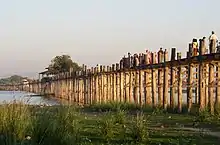
Maung Bein (Burmese: မောင်ပိန်), known by honorific U Bein (Burmese: ဦးပိန်), was a Burmese court official and clerk of Amarapura Count Bhai Saab.[1] He is remembered for building the U Bein Bridge.[2] The bridge was built from wood reclaimed from the former royal palace in Inwa.[3] He also served the King Pagan along with Count Bhai Saab in the closest proximity of all government officials and often enjoyed great power that was derived from the king's favor.[4] Maung Bein and Bhai Saab are some examples of powerful figures who were the most powerful officials of their time.[5] As favorites of the king, they held unrivaled power, making them beyond competition. They gained a notorious reputation for persecuting the people.[6][7] Eventually, King Pagan recognized their transgressions and ordered their execution. It's noteworthy that Maung Bein was a Muslim, despite having graduated from a Burmese monastery.[8]
References
- ↑ thoṅʻ, Pacʻ tuiṅʻʺ (1993). Myuiʺ khyacʻ citʻ dhātʻ thakʻ sanʻ reʺ choṅʻʺ pāʺ myāʺ (in Burmese). Pranʻ krāʺ reʺ Vanʻ krīʺ Ṭhāna, Sa taṅʻʺ nhaṅʻʹ Cā nayʻ jaṅʻʺ Lupʻ ṅanʻʺ.
- ↑ Mranʻ māʹ cvayʻ cuṃ kyamʻʺ (in Burmese). Mranʻ mā Nuinʻ Naṃ Bhā Sā Pranʻ cā Pe ʹA Sāṅʻʺ. 1954.
- ↑ Vaṅʻʺ (Ma), Taṅʻ (2001). ကုန်းဘောင်ကိုဆန်၍ (in Burmese). Cvanʻ Rai Cā pe.
- ↑ Ūʺ.), Ññui Mra (ʾUiʺ ve (1997). Kunʻ ̋ bhoṅʻ rhā puṃ toʻ (in Burmese). Mravatī cā pe tuikʻ.
- ↑ Nvayʻ, Natʻ (2002). Mranʻ mā praññʻ mrokʻ puiṅʻʺ (in Burmese). Khyui Teʺ Saṃ Cā pe.
- ↑ Sanʻʺ (Ūʺ), Bha (1953). Kyanʻ ̋suṃ ̋mranʻ mā rā ja vanʻ (in Burmese). Thvnʻ ̋thvnʻ-̋kvmʻ pa ṇī.
- ↑ Ketu, Mra (1998). Nanʻʺ mū nanʻʺ rā Mra Ketu cā poṅʻʺ khyupʻ (in Burmese). Rvhe Pu ra puikʻ Cā pe Tuikʻ.
- ↑ "ကမ္ဘာကျော် ဦးပိန်တံတားကြီး၏ရှုခင်းအလှများအား ယခုနှစ်တွင် ခရီးသွာများပိုမိုလာရောက် လေ့လာလျက်ရှိ". Myanmar DigitalNews (in Burmese). 7 April 2019.